Hello Plant Friends,
For the past few weeks, we’ve been talking about the COVID-19 virus. Focusing on symptoms, stages of progression and treatment strategies. This week I’d like to talk about fever and the role of a fever in disease management from an herbalist’s perspective.
Following are general suggestions for fever and fever management from an herbalists perspective. Although the information is helpful for fevers of all kinds, special combinations may be needed when working with the COVID-19 virus.
Overall, when addressing the coronavirus, the formula may need to be more heating, even when the fever is hot and strong. This can be accomplished by adding a warming agent to the formula like a pinch of cayenne. Our grandmothers used to meet the same need by adding a teaspoon of whiskey to a cup of tea.
Let’s start by understanding the purpose and actions of a fever. Then we’ll move to herbal solutions and other suggestions we can used to support the system.
What is a Fever?
A fever is a temporary raising of the body’s temperature. Our average body temperature can, and often does, fluctuate between about 97 F (36.1 C) and 99 F (37.2 C). Your temperature usually varies depending on time of day, activity level and age, among other things. Generally, older people have lower average temperatures than younger people. And in the morning temps tend to be lower than in the evening.

Fever is more than a symptom of disease. It is confirmation that your immune system is on the job against foreign substances like viruses, bacterial and other pathogens.
When your body detects unfamiliar or possibly damaging elements, the immune system becomes triggered. The hypothalamus (a gland controls a healthy heat in the body), shifts to a higher base temperature. The resulting increase in bodily temperature triggers cellular mechanisms that tell the immune system to increase peripheral circulation and raise the metabolism.
During a fever, white blood cells and other helpful antibody production increases as much as 20-fold. That’s like 2000%. Offending disease-causing pathogens are killed by the increased heat, and excess toxins are removed from our systems.
Most fevers are not dangerous.
Fever is a vital part of our natural defenses. Even through it’s not comfortable, the process of a fever is one that should be supported. A temperature of up to 102°F is generally good for you. It’s normal for human temperature to raise as high as 103 or even 104 when fighting off an infection. Most healthy adults can tolerate a fever this high for short periods of time.
Here’s a basic outline of what happens as the heat rises. Taken from Paul Bergner’s paper Treatment of Acute Febrile Disease (2003).
- 96.5 in the morning to 99 degrees in the evening is considered a normal range.
- 98 to 99 degrees the influenza virus dies.
- At 99.5 the digestive system shuts down. Our body re-allocates the extra resources toward ridding itself the offending pathogen.
- 101 to 102 degrees is the optimal temperature for a fever.
- 104 degrees is considered the upper range where most bodily functions are not altered.
- Fevers above 104 degrees can be dangerous.
- 106 is the limit the normal human body can sustain and is a likely threshold for seizure activity.
- 108 degrees and brain damage can occur.

When to Seek Help for a Fever
Seek medical help for a fever if
- Your fever raises quickly. For example, if your fever goes from 99 degrees to 104 degrees in less than 2 or 3 hours
- If a high fever persists for more than 4 days.
- When fever raises higher than 104 degrees and does not respond to intervention.
- A purpuric rash is present. That is a purplish discoloration of the skin produced by small bleeding vessels near the surface.
- Signs of meningitis including headache, stiff neck, lethargy, vomiting and convulsions along with a quick high fever.
- Fevers of 103 and up can be dangerous for folks with cardiac disease. High fevers can put excess strain on the heart and blood vessels. These folks should stay in close contact with their doctor and may need to employ fever suppressants to stay safe.
Symptoms of Fever from an Herbalists Perspective
At the first signs of a fever you may experience a generalized malaise or feeling of unwell. Further symptoms may include aches and pains, chills, headache, sweating, feeling flushed, lack of appetite, low energy, and dehydration.
During the early stage of COVID-19 there is often a low-grade fever of about 100 to 101. Later, if the virus progresses the fever may rise to 103 degrees. Many people who have recovered from the new coronavirus have reported a sustained temperature of 103 degrees that lasted for several days.
The chief concern with any kind of fever is dehydration. Metabolic exhaustion can also occur. Especially in elderly or debilitated people, or if the fever is extended for several days.
Febrile Convulsions
Very high fevers or sudden changes in temperature can cause febrile convulsions. Although febrile seizures are common and benign in children, they are not normal in adults. For children febrile seizures are the body’s attempt to catch up to the change in body temperature. And while alarming, are in themselves they are not necessarily dangerous.
In an adult however, seizures related to a fever means can indicate a dangerous situation. If you are experiencing convulsions with a fever as an adult take immediate action to lower the fever. And call your doctor. Below you’ll find some strategies for bringing the temperature or a fever down quickly.
Types of fever
There are two basic types of fever based on symptoms.
Cold and Shivery Fevers
Cold and Shivery fevers are characterized by a chilly feeling from the inside, like you can’t warm up. The forehead may feel warm or hot, but the body often feels cool the touch. The pulse may be week. The presence of goose bumps means that the pours on the skin have closed in an effort stop sweating and prevent heat loss.
Hot and Strong Fevers
Usually a productive fever, between 102 and 104 degrees. Your body and immune system are are working hard.
The skin may be hot and dry. The pulse full, strong and fast. Feelings of tiredness or drowsiness and muscle aches indicate the harvesting of amino acids from muscle tissue to be re-directed to immune activity.
With this type of fever the appetite usually decreases as digestive energies are turned inward. Blood chemistry changes as iron and zinc levels decrease in an effort to starve offending pathogens.
Treatment Strategies
The fever is an ally, not an enemy. Therefore, it’s best to support the fever as a vital immune force. Fever suppressant drugs like Ibuprofen, Aspirin, Tylenol can cause there own problems and are best avoided if possible.
General suggestions for all types fever types
- Drink lots of liquids. Dehydration is the biggest concern for most fevers.
- Drink broths or eat easy to digest foods. Chicken soup and Kitchari are good examples.
- Add herbs to your broth
- Rest
Working with a Mild Fever
With a low grade or mild fever, the main strategy is to prevent it from becoming a strong one. That means working to create a healthy environment. One that is inhospitable to foreign agents such as virus and bacteria.
- Rest
- Drink lots of liquids.
- There may be no need for herbal remedies at this point, but I like a hot tea with lemon, ginger and peppermint.
- Echinacea and other anti-viral and immune stimulating herbs may be helpful. Small frequent doses may be best.
- Get out in the sunshine (in a relaxed way).
Treatment Strategies for Cold and Shivery Fevers
When working with cold, shivery fevers the first thing is to get warmed up. Once the body is warm, use stimulating diuretics to promote sweating. It can take a few hours to bring the fever to a point where it “breaks”. When a fever breaks there is usually profuse sweating and a lowering of the overall temperature.
- Support the bodies need to warm up.
- Wrap yourself up in a warm blanket and or take a bath
- Drink hot liquid, tea and broth
- Stay in a warm room away from drafts.
- Use stimulating, warming, diaphoretic herbs to promote sweating.
- Some of my favorite herbs for this are Yarrow, Monarda, Ginger, Angelica, Cayenne and Garlic.
Yarrow Achillea millefolium
Yarrow is best taken as a hot tea or tincture in hot water for cold and shivery fevers or to promote sweating. Small frequent doses seem to work the best. For children, consider 1 ml (10-20 drops) of the tincture in hot, sweetened water. For adults the dose is up to 60 drops of the tincture in hot water, sweetened or not. Both children and adults may take yarrow every 1 to 2 hours.
To make a tea, use 1 tablespoon of the herb in 16 oz of boiling water. Steep for 10 to 20 minutes. Drink about 4 oz every 2 hours until perspiration starts. Then continue every 4 to 6 hours until the fever has run its course.
Yarrow is an excellent herb to add into any formula for fever. It brings on sweating for both cold and shivery and Hot types. This herb also helps maintain metabolic energy. Having a fever for several days can be draining. This herb seems to help us maintain the stamina our body needs to do the work fever represents.
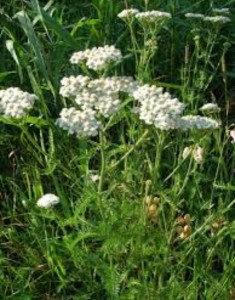
Ginger Zingiber officinale
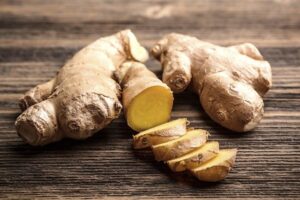
A fabulous stimulant and diaphoretic in cases of fever. Ginger is also useful for colds and flu as well as viruses and bacteria of all sorts. It helps soothe muscle pain and supports the digestive system, among other things.
Grate about a teaspoon of fresh ginger (or use a little dried ginger) in a cup of boiling water. This is supper yummy with lemon and ginger. Take 2 to 4 ounces every hour or two until perspiration starts. then every 4 to 6 hours until the fever resolves.
Monarda fistula
Monarda, also called Wild Oregano, is a warming, stimulating diaphoretic that works well for cold types of fever. This herb is often indicated for coughing, to clear mucus and to protect the mucus membranes. It tastes great in tea but works as a tincture or syrup as well.
Garlic Allium sativum
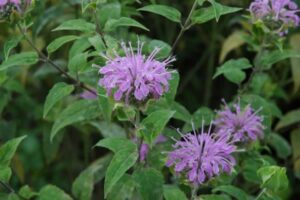
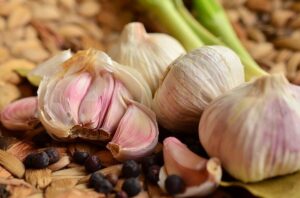
Heating and stimulating, garlic is a common common kitchen herb. Fresh garlic can be eaten or made into an oil (see recipe below). To eat the garlic, chop it up a little. Let sit for 5 minutes and eat. Eat 1 garlic clove every 3 to 4 hours.
Garlic can also be added to tea or taken as a tincture.
Herbal Strategies for Hot and Strong Fevers
When a fever is high and hot, our goal is to enhance productive perspiration, keep the temperature in a healthy productive range (102 to 103), and to make ourselves as comfortable as possible.
Botanically we’ll employ cooling, diaphoretic herbs, especially when there is little to no sweating. Diaphoretic herbs promote perspiration, and thus the bodies ability to cool itself. The act of sweating also releases built up toxins or used up immune cells from the body.
When the fever is hot and strong
- Drink warm or lukewarm water and tea rather than hot liquids.
- Take tepid or lukewarm baths (not cold)
- Keep your metabolism as strong as possible with nutritional broths and easy to digest soups.
- Cooling diaphoretic herbs useful for hot and strong fevers include Elderflower, Peppermint, Lobelia, Catnip, Butterfly weed (Asclepias tuberosa), Burdock, Boneset (Eupatorium perfoliatum) and Verbena.
Peppermint Mentha × piperita
Peppermint tea is a nice choice for a hot and strong fever. It may be added to your formula or taken alone as a tea. Cooling and diaphoretic, Peppermint is traditionally used to reduce fever and help relieve symptoms of headache, muscular aches and pains and digestive upset that often accompany a fever. This herb also supports the digestive system and works to relieve congestion.
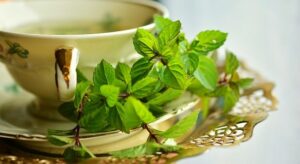
Elder flower Sambucus nigra
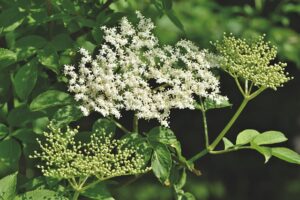
A traditional herb used to treat cold, flu and fever, Elder flowers have a cool, draining, drying and diaphoretic energy. Our fore-mothers often combined this herb with with yarrow, ginger or boneset for infections, fevers and chills. It was combined with goldenrod (Solidago) for cold & sinus infections with excess mucous.
When working with respiratory conditions like asthma and allergies, the flowers of the Elder bush are well combined with white horehound.
Boneset Eupatorium perforatum
Historically used in cases of high fever, Boneset is named for it’s use in the treatments of Denge or “breakbone” fever. A painful virus with a high fever. One of the symptoms is that if feels like your bones are breaking.
Boneset increases circulation to the skin and encourages strong diaphorphoretic action. It also has immune modulating actions that help increase white blood cell count and general immunity. This makes it an excellent herb for working with colds and flu.
Often employed in fevers with or without chills. Boneset combines well with Yarrow, Elder flower and Prickly Ash as a cold/flu formula.
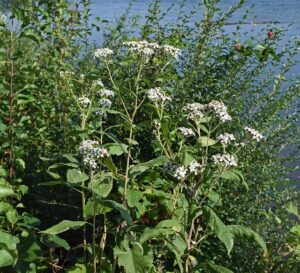
To Quickly Lower a Fever
Sometimes, circumstances warrant immediate action to lower the fever. For example, if the fever is over 104, or it has been present for several days. You may want to lower the fever if there is undue stress on the system. For example, if the person is elderly or has another underlying condition.
Listen to your instincts. If you feel the fever has gone on long enough or your feeling uncomfortable with the whole thing, you can lower a fever using lukewarm or tepid (never cold) water.
- Take a lukewarm bath. The water should feel slightly warm to the touch. I like to add a few drops of Lavender Essential oil and some Epsom salts to help with the fever and relieve some of the tension and muscle aches.
- Lukewarm or tepid water as a compress for the face, eyes or forehead
- Sponge bath with lukewarm or cool water.
Cool Sheeting to Lower a Fever
In extreme cases of a high fever, wet towels or sheets in tepid water (warm to the touch but not cold). Strip the person with the fever and wrap in the sheets for up to 20 min. Remove the sheets and re-take the temperature, Giving them lots of water. If they start shivering, place a light blanket to warm them and re-check the fever.
Botanicals to lower a fever
Herbs like White Willow, Meadow Sweet, Violet and Usnea may help to lower a fever. Herbs that contain berberine like barberry root, Oregon grape root and golden seal are also effective in lowering body temperature.
Meadow Sweet Filipendula ulmaria
Containing salicylic acid, Meadow Sweet herb works much the same as an herbal “aspirin”, although through a different mechanism. Meadow Sweet helps relieve pain, inflammation and Fever.
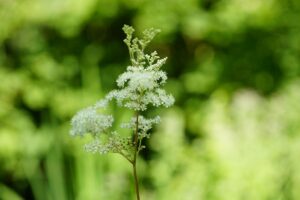
Violet Viola tricolor
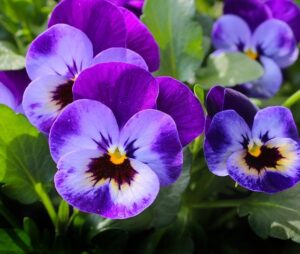
Violet plants are gentle and soothing. In Traditional Chinese Medicine Viola is considered a powerful detoxifier. A cooling and soothing fever reducer, Violet also helps address a sore throat, as well as a variety of lung complaints from asthma to bronchitis.
Barberry Root Berberis vulgaris
A cooling and drying herbal antibiotic and antiseptic, Barberry helps lower a fever, protect the liver and heal mucous membranes. I like to use Barberry as a tincture, but it works well as a boiled tea or decoction.
Most of the herbs from the Berberis family contain the active constituent berberine and can be used interchangeably. Berberis family herbs include Oregon Grape, Algarita and Goldenseal.
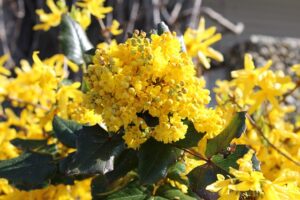
Starve a Fever
This famous axiom has its roots in truth. When a fever is above 99.5 the digestive system essentially shuts down. The energy normally used for digestion is redirected to immune system functions. Most of the time we simply won’t have any appetite. Broths and soups are good at this time. Foods that are easy to digest and don’t tax the digestive system are also ok. Chicken soup and Indian Kitcari both famous for providing nourishment and energy while ill or feverish. Once the fever has abated, our appetite will return.
Upon recovery, eat light, easy to digest foods for a few days. Rest and take it easy. It’s important to give yourself time. You may find that at the end of a fever or illness, you feel better than you have in years.
Recipes - Fever from an Herbalists Perspective
Possible formula for Cold and Shivery Fevers
- 1 part Yarrow
- 1 part Monarda
- 1/2 part Ginger Root
Mix herbs or individually formulated tinctures. For tea use 1 teaspoon herb for 8 to 10 oz boiling water. Steep 10 to 20 minutes. Drink hot. May be sweetened with honey. To Use the tincture add 30 to 60 drops to hot water and sip. Take 4 oz hot every 1-2 hours until sweating begins. Continue to take 4 oz every 4 to 6 hours for the remainder of the fever.
Possible Formula for Hot and Strong Fevers
- 1 part Elderflowers
- 1 part Yarrow
- 1 Part Boneset
- 1 part Peppermint
Mix dried herbs or individually formulated tinctures. For tea use 1 teaspoon herb for 8 to 10 oz boiling water. Steep 10 to 20 minutes. Drink room temperature or lukewarm. May be sweetened with honey. To Use the tincture add 30 to 60 drops to lukewarm water and sip. Take 4 oz hot every 1-2 hours until sweating begins. Continue to take 4 oz every 4 to 6 hours for the remainder of the fever.
Garlic Oil
Take 1 or 2 whole bulbs of garlic Put it in the blender skin and all (you can chop it, if you like) Add 2 or 3 cups olive oil ( or any oil you have handy) Blend well.
Pour the garlic sludge into a jar the can seal and let settle. Once its settled add oil so that the oil is at least 2 inches above the chopped or ground garlic.
Place the sealed jar in a hot water bath for about 24 hours, less if you need it sooner. A crock pot on low or warm works well for this because you don’t want to cook it on a high temp. You should be able to pick up the jar and shake it comfortably several times per day. Strain the oil through a cheesecloth or similar material. There you have it.
Rub this on feet and chest to remove congestion and help breath easier. ****Warning***** This oil can be hot. Test it on the inside of you arm to check the heat. If too hot, especially for children dilute with additional oil as needed.
Further Reading

Product Suggestions from Wonderment Gardens
Thank you for taking the time to read. I hope you find the information useful. Please don’t hesitate to contact Annie Here if you have any questions or additional ideas.
Blessings
Annie
References
Bergner, Paul; Treatment of Acute Febrile Disease, 2003, Southwest Conference on Botanical Medicine Conference notes.
https://www.mayoclinic.org/first-aid/first-aid-fever/basics/art-20056685
Barlow, Teresa and Scott, Julian, Herbs in The Treatment of Children, Leading a Child to Health, 2003, Churchill Livingston, St. Luis Mo.
Wood Matthew, The book of Herbal Wisdom; 1997, North Atlantic Books, Berkley, California
https://jmedicalcasereports.biomedcentral.com/articles/10.1186/1752-1947-5-364
Disclaimer
The statements and ideas presented here are not intended to diagnose, treat, cure, or prevent any disease or condition. They have not been evaluated by the FDA. All ideas presented are for the sole purpose of education. To help you take control of your own health. If you have a health concern or condition, consult a physician. We suggest that you always consult a medical doctor before modifying your diet, using any new product, drug, supplement, or doing any new exercises.
These statements and products have not been evaluated by the FDA. They are not intended to diagnose, treat, cure, or prevent any disease or condition. If you have a health concern or condition, consult a physician. Always consult a medical doctor before modifying your diet, using any new product, drug, supplement, or doing any new exercises.
Herbs taken for health purposes should be treated with the same care as medicine. Herbal remedies are no substitute for a healthy diet and lifestyle. If you are serious about good health, you’ll want to combine diet, exercise, herbals, a good relationship with your doctor and a generally healthy lifestyle. No one of these will do it alone.
This information is designed to be used as part of a complete health plan. No products are intended to replace your doctor’s care, or to supersede any of his/her advice or prescriptions.


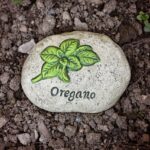


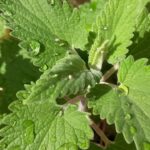
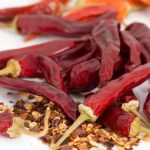
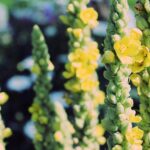
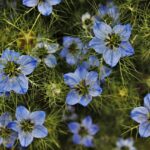
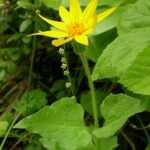


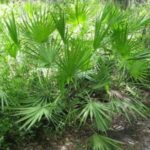










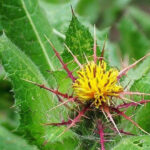
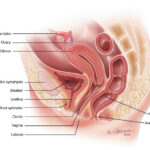


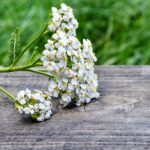
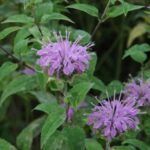


Pingback: Herbal Interlude with Yarrow - Wonderment Gardens